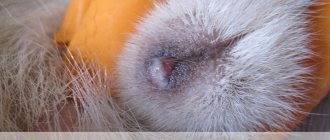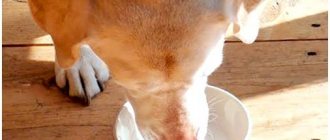Discharge in a pregnant dog is normal. Discharge refers to the appearance of fluid or mucus other than urine from a loop. Normally, in a healthy dog, the loop is always slightly moistened, the discharge is clean, transparent and odorless, does not collect in drops, and does not contain thick mucus. But sometimes the discharge changes and this often worries the owners. Dog breeders pay especially close attention to discharge from dogs during pregnancy. They can be different throughout the pregnancy and depending on whether it proceeds safely. Therefore, it is very important for the owner to monitor his dog.
What are discharges?
Discharge from the loop in dogs can be seen on the fur around the genitals. Sometimes the liquid remains on the animal's bedding or on the floor.
Discharges have a different character and can be:
- transparent;
- greenish;
- mucous;
- white;
- dark.
If you notice something like this, you should not panic. In most cases, the secretion does not cause harm to health, being the norm .
Diseases that negatively affect pregnancy
Excessive discharge often indicates pathology related directly to the organs of the reproductive system. In order to recognize alarming symptoms in time, it is important to familiarize yourself with the list of such diseases that pose a danger to a pregnant bitch.
Table. Diseases aggravating pregnancy
| Disease | Description | Symptoms |
| Vaginitis | Vaginitis is an inflammation of the vaginal mucosa that occurs as a result of the penetration of pathogenic microflora. The causes of vaginitis are hormonal imbalances, metabolic disorders, as well as infections (sexually transmitted or already existing in the body in a chronic form) | There are several types of vaginitis: serous, catarrhal, purulent, and so on. They are united by the presence of whitish discharge, which may have a sharp or (in the case of catarrhal form) sour odor. The most severe is gangrenous vaginitis, since it is accompanied by tissue necrosis |
| Pyometra | Pyometra involves inflammation of the uterus, which can be of two types: closed and open. The closed form is more dangerous because in it the pus is not able to leave the uterus, leading to serious consequences. The open form suggests the presence of purulent discharge from the female loop. In some cases, pyometra becomes chronic and does not have pronounced symptoms. | Closed form: 1. Refusal to eat. 2. Lethargy. 3. Increase in temperature. 4. Fever is possible. 5. Constant thirst. 6. An obsessive desire to empty the bladder. 7. Bloating of the lower abdomen. Open form: 1. Slight decrease in appetite. 2. Slight weakness. 3. Purulent vaginal discharge |
| Inflammation of the vaginal opening | This inflammation is not a disease as such, but can lead to various pathologies. As a rule, inflammation of the vaginal opening begins with damage during mating, if the partner is not very skilled | Discharge of a serous substance similar in consistency to sour cream |
Don't overdo it with hygiene!
In the fourth week of gestation, the dog may release liquid mucus from the “causal site” after urinating.
It looks like human snot. There may be dark veins in the mucous contents. Fresh blood in such secretions is an alarming sign. Most dogs are in a hurry to lick “evidence” such as discharge. But an attentive owner will still notice a drop of mucus on the dog. If it is not thick, without a pungent odor, nothing bad happens.
Inexperienced dog owners are often scared when they see brown discharge from a dog’s vagina. Some people, succumbing to panic, wipe the animal’s intimate area with solutions containing an antibiotic. Of course, this should not be done. After all, antibacterial drugs can harm a pregnant animal (at least by causing irritation of the bitch’s vagina).
Vaginal discharge before labor begins
If you and your pet are expecting the birth of puppies, this is always accompanied by certain worries and anxieties. Therefore, it is worth paying special attention to the fluid that is released from the pet’s vaginal area during the onset of labor.
It is very important at this moment to support the animal in every possible way, since the owner’s mood most directly affects the general condition of the pet. It is very important not to disturb the dog at this moment, as the bitch may react inappropriately, especially for small children.
In addition to the fact that thick mucus is lying around during this period, the animal may experience diarrhea, which is due to the maximum relaxation of the entire muscular system as a whole.
If you notice streaks of brown or red blood in the mucus, this indicates the release of the mucus plug and the complete opening of the birth canal.
You should be very careful if your pet’s body temperature rises during the birth process, this may indicate the development of a postpartum inflammatory process, which requires urgent consultation with a highly qualified specialist.
Causes of discharge
During pregnancy, the condition and structure of the genital organs change. From this time on, the body begins to work differently.
Dogs have an ovarian type of reproduction, therefore, as a result of the influence of sex hormones, follicles - sex gametes - mature in the ovaries.
The process leads to maximum production of progestins, estrogens, and androgens by the ovaries.
In order for the fertilized egg to attach, a preparatory stage takes place in the uterine cavity.
The endometrium (inner layer) ceases to be dense, softens, and swells. At this point, mucous discharge is observed, which sometimes continues during pregnancy.
After a successful mating, the dog begins to secrete a weak secretion. This means that fertilization was successful and there is no cause for concern. Normally, 3 weeks after mating, the owners notice other discharge.
The secretion makes itself felt only after urination. Having noticed mucus, there is no need to run to the doctor, because the discharge is a reaction to the male sperm. Normal color ranges from whitish to light yellow. There is no smell.
Unfertilized oocytes are released with a light secretion. In the middle of pregnancy, more precisely 20 days after mating, the cervix “closes”. This can be understood by the whitish discharge.
Sometimes blood spots are observed in the mucus, but in insignificant quantities. This physiological reaction of the body indicates the absence of deviations.
Discharge in a dog during pregnancy
I would like to start with the fact that vaginal discharge in one form or another accompanies the female throughout her pregnancy; this is a common physiological phenomenon. Normally, there should be a small amount of discharge, sufficient to ensure the balance of the genital mucosa.
After mating
It is believed that during the first few days after mating, the bitch should have virtually no vaginal discharge of any kind. However, some females have whitish drops, which are the animal’s body’s reaction to the partner’s seminal fluid.
The consequences of mating are individual and depend on the physiology of a particular pet.
The active secretion of clear mucus a couple of days after mating is explained by the following factors:
- The mucus plug that previously covered the cervix leaves the uterus after sexual intercourse. She does this in parts, so the process can drag on for a couple of weeks;
- mucus removes oocytes that remain unfertilized from the female’s body;
- After sexual intercourse, small amounts of blood clots may come out of the animal’s vagina along with mucus. This condition does not threaten the animal’s condition and is a variant of the norm.
Clear discharge after mating is common in dogs.
First weeks of pregnancy
At the initial stage of pregnancy, the animal’s uterus, like other genital organs, undergoes significant changes, changing its size and structure. The inner layer of the uterus swells and becomes looser, preparing to receive an egg. As a result, quite a lot of mucus is released, which partially exits through the loop.
By the way! If you have difficulty determining whether your dog is pregnant, we recommend that you read the article on this topic on our portal.
In the early stages, the enlargement of the uterus is not noticeable, and discharge is not so frequent
If within a few days after mating you notice secretion from the bitch's vagina, then this is a sign that fertilization is most likely successful. Three weeks after mating, you may also notice patches of mucus accompanying the animal's urination. This sign is further evidence that the female has become pregnant.
Changes in the dog's body
As a rule, it is difficult to determine the pregnancy of a bitch until the third week inclusive. However, by the end of the third week, the female’s belly begins to grow, and the following changes rapidly occur in her body:
- filling the space of the uterus with amniotic fluid, as a result of which this organ “swells”, along with it the female herself increases in size;
- the movements of the embryos are already recognized by the mother, despite the fact that they are still very insignificant and consist in the movement of puppies along a hollow organ;
- due to the enlargement and filling of the uterus, mucus begins to actively secrete from the female’s loop, which sometimes remains hanging from the animal’s genitals. If you don't wash your dog often enough, this mucus will form a crust that can be confused with a dried wound due to its brown hue and resemblance to ichor;
As the embryo develops, the uterus begins to fill with amniotic fluid.
- in some cases, green or black specks may be observed in the mucus, which represent embryos rejected by the uterus. If you notice such clots, do not worry about the dog’s health: rejection of some dead fetuses in the early stages is normal. Moreover, sometimes these underdeveloped fetuses remain in the uterus until the moment of birth.
Also, the end of the third week is significant in that it coincides with the closure of the cervix, which clearly indicates pregnancy. If from the third to fourth weeks the discharge looks more like water with small patches of mucus, then after the first month it thickens, but retains its translucent hue. This type of mucus forms a kind of protective barrier.
At the end of the first month, the female’s belly begins to gradually grow
To avoid the formation of crust, which we discussed above, it is advisable to periodically wash the female's perineum. It is recommended to wash the animal’s vagina using:
- clean water at room temperature;
- baby sanitary napkins.
It is not advisable to use soap as it may irritate it.
Before birth
The following weeks rarely cause the dog's owners any concern regarding its discharge. However, before giving birth, the dog again produces large amounts of mucus, which often attracts the attention of concerned owners. Intense mucus secretion gives a signal that the dog will begin labor in one or two days.
Shortly before giving birth, the dog's protective plug begins to come off.
This secretion represents the protective mucus plug that we discussed in the previous section. And if in the first month of pregnancy this plug was actively formed, then a couple of days before birth it is rejected, freeing the genital tract through which future puppies will move during the birth process. Mucus can have several shades:
- white;
- light green;
- light brown;
- transparent.
It also happens that the protective plug does not come off in parts, but all at once - during urination. In this case, the owner can easily miss this manifestation, indicating an imminent birth.
Sometimes the protective plug comes off without the dog owner noticing.
Other signs of imminent labor
In addition to the loss of the protective plug that accompanies the end of pregnancy, you can determine the bitch’s readiness for childbirth by the following actions:
- the dog is actively trying to dig a hole in the floor or in the yard because its goal now is to create a “shelter” for its young;
- Often the behavior of the female changes radically: she either persistently seeks the company of her owner, or demands complete solitude.
It all depends on the animal’s ideas about comfort and security; Before giving birth, the dog looks for a secluded place for itself and for its cubs - before giving birth, the dog chooses one of two types of behavior - calm and relaxed or tense and somewhat aggressive. Both behavioral scenarios are the norm and act as a natural reaction of the animal to changes in the body.
You can read below about how to prepare for the birth of your dog.
Preparing for the birth of a dog
After childbirth
At the end of childbirth, the uterus continues to cleanse itself, removing the remains of proteins and tissues, therefore postpartum discharge is an obligatory occurrence in the life of every female. During the first few days, the owners of a bitch who has given birth observe the following types of discharge from their pet:
- whitish discharge with green splashes. The greenish tint of the substance is given by proteins exiting through the genital tract, which are no longer needed by the mother’s body;
- dark burgundy discharge that does not have any odor should also not alarm the owners of the animal, if the dog does not experience discomfort and does not show signs of pain. Normally, such discharge ends on the second or third day after birth.
After giving birth, your pet's uterus continues to cleanse itself for a month.
Womb cleansing occurs within the first few weeks after the puppies are born. Already in the first week, the rich color of the discharge gradually dilutes, becoming more and more transparent. Moving at this pace, after a month the discharge should stop altogether. However, these dates may vary depending on the number of cubs in the litter.
Important! If the discharge continues to be intense after a month, it is highly recommended to consult a veterinarian.
The first weeks after the “date”
If a dog has mated with a “groom”, this does not mean that conception has occurred.
It is no secret that many bitches develop a false pregnancy after an unsuccessful mating (and even without contact with a male dog). The pet’s appearance changes (the dog’s belly becomes rounder, its nipples swell). The animal’s behavior also undergoes strong changes: the dog sets up a “nest”, drags soft objects (mittens, toys) there that resemble puppies... The owner will understand the deceptiveness of his dog’s “pregnant status” only after consulting a veterinarian. Meanwhile, a successful mating may not affect the dog’s mental state in any way. Moreover, many bitches continue to be in heat for several days after conception.
The animal, of course, will not tell you about its interesting position. You will know that a dog is bearing offspring by its physiological signs. One of them is discharge from the animal’s loop. These discharges (or rather, their color, thickness, smell) can not only inform you that the bitch is pregnant, but also warn you about a serious illness or aborted fetuses.
Discharge after mating
If a bitch was mated with a male, there is no guarantee that conception occurred. It is worth knowing that after an unsuccessful mating, a false pregnancy may periodically appear even without the participation of a male dog. The appearance of the female resembles her behavior during pregnancy, including physiological changes, but the veterinarian will be able to determine for sure whether conception has occurred.
Most bitches, after successful conception, may not respond to semen in any way, and estrus continues for several days. Only after a while does the discharge disappear. It is possible to accurately identify that an animal is pregnant by the presence and quality of discharge.
The owner who monitors the health of his pet should be wary of the appearance of blood in the mucous secretions. Mostly blood is a negative factor and indicates any abnormalities in the body, but there are cases when such a phenomenon is considered within normal limits. Most likely, the bitch’s body reacts to the process of conception by secreting blood.
Is it normal to have discharge from the loop?
The secretion released from the animal's vagina can be observed throughout pregnancy. The nature of the mucus will change, but the liquid will not disappear anywhere.
You should go to the veterinarian when:
- discharge is abundant;
- the dog behaves restlessly, which is excluded in the early stages of pregnancy, the animal may rush about, hide, whine;
- mucus becomes dark in color;
- the secretion contains blood;
- the animal refuses food.
Such deviations should not be normal, although many bitches behave strangely for the first time. However, it's better to be safe than sorry.
Miscarriage
In the context of pathological discharge in a dog, we will pay special attention to the phenomenon of miscarriage. When a bitch has a spontaneous abortion, exudate is released from the vagina, which can be dark green or black in color, and also contain bloody spots and pus. In some cases, the uterus rejects only part of the fetuses, while others are not in danger. However, regardless of whether the entire litter was rejected, it is necessary to visit a doctor and develop a plan for further action with him.
Miscarriage in late pregnancy
Causes of miscarriage
Unfortunately, it is not possible to completely prevent the possibility of spontaneous abortion today. All the owner can do is to carefully monitor the health of the pregnant bitch in order to prevent the development of the following situations:
- infectious diseases (prevented by vaccination carried out before mating);
- parasitic infestations (as with infections, parasites can be easily controlled with the help of anthelmintic and ascaricidal drugs);
- exhaustion or obesity of the animal (during pregnancy, the bitch’s diet changes, which is important to consider when feeding her);
Throughout pregnancy, it is important to prevent the animal from gaining too much weight.
- inappropriate age for mating (boughs that have already had their first heat and whose physiological development has successfully completed should be allowed to mating);
- inbreeding (inbreeding should be avoided under all circumstances);
- taking a number of medications (if the bitch was taking any medications before conception, you should consult with a veterinarian in advance about the compatibility of medications with the planned pregnancy);
- damage and injury (during pregnancy, the bitch is especially vulnerable to various injuries, and a miscarriage can occur even if the injury is not on the stomach, so any active games with the dog during the gestation period are prohibited).
Possible complications
If you notice any alarming symptoms, including a significant deviation from the planned date, call your veterinary clinic immediately. It is better to be wrong in your guesses than to allow the death of your four-legged pet and her babies.
Ectopic pregnancy
The development of embryos outside the uterus is fraught with death due to internal ruptures and bleeding. It is accompanied by pain and bloody discharge from the uterus. If the animal whines and blood flows from its loop, call a doctor.
False pupishness
False whelping, or false pregnancy, can be easily determined independently only by the absence of mating. This condition is accompanied by similar symptoms, but instead of labor, it can result in mastitis or other complications. Due to the likelihood of such an outcome, veterinarians recommend not to refuse blood donation, ultrasound and x-rays.
Frozen pregnancy
Partial or complete death of embryos is fraught with mummification with subsequent intoxication of the body. If the dead fetuses do not come out on their own, they are removed by artificial stimulation of the uterus or by sterilization.
If the dog paces
A delay of more than 10 days is an alarm bell. In addition to the death of the fetus, the reason may lie in a delay in its development, pathologies of the genital organs of the bitch, or other diseases of the four-legged woman in labor. Healthy babies are removed by caesarean section.
Early discharge
During this period, there must be a secret. Its absence may indicate an unsuccessful mating or a false pregnancy.
Transparent mucous discharge, reminiscent of what happens with a runny nose, is a signal that the body is rejecting embryos that died earlier. There is nothing wrong with this, the process is natural.
All embryos cannot take root, otherwise there is a risk of a large number of puppies that will not be able to gain the required weight during intrauterine development. Sometimes the secretion is so abundant that it sticks to the fur of a dog that does not have time to lick it.
In this case, the animal should be helped by removing the mucus. A clot is sometimes found in the discharge; it can be green or black.
However, in rare cases there may be no discharge, in which case the embryos will be released during childbirth.
The appearance of blood in the discharge
It is worth noting that such a signal is not always a consequence of pathology. If the discharge does not last long, the dog’s activity does not change in any way, the color of the blood is quite dark, and the amount is small, then there is no serious cause for alarm.
Mostly 1-2 days before birth, a clear or white liquid is released from the loop. In some cases, light green or brown mucus may appear. The brown color is a consequence of getting into the blood secretions. The reason is burst capillaries, as a result of dilatation of the cervix. There is nothing serious in this case; such a signal indicates an imminent birth. Eclampsia may occur.
It is normal for the mucus plug to peel off 20-40 hours before birth, which is accompanied by blood and a yellowish color. In this case, the discharge may be insignificant and even unnoticeable.
If the discharge of blood is profuse and the mucus turns dark brown in color, it is likely that one puppy has died, which requires a visit to the veterinarian; birth at home cannot be performed. A large amount of dark or light blood may indicate that the uterus has ruptured; this is dangerous for the health of the animal and the fetus. The dog will need urgent hospitalization and help from a veterinarian.
It is normal for blood to appear for some time after childbirth, mostly healing occurs after 2-3 days. If blood clots continue to be released, there is a high risk of bleeding in the uterus, which can only be eliminated in the clinic with the help of hemostatic drugs, but they have many contraindications and therefore require medical supervision.
In general, excessive bleeding is always a sign of pathology. Small particles of red or brown color should alert the owner, but there is no need to take any action for treatment. It is advisable to consult a doctor.
The course of pregnancy after 1 month
At this stage, before the crust forms, long green or black clots may stretch from the loop - these are embryos that died in early pregnancy. There is nothing wrong with this; this is a normal scheme for cleaning a dog’s uterus provided by nature. If the dead embryos remain in the uterus, they will mummify and be expelled during childbirth. There is nothing dangerous in this either (a complete list of the course of pregnancy by day).
If the bitch is not fertilized, she also needs to be monitored. Such discharge, coupled with swollen milk bags and saggy nipples, may indicate a false pregnancy - an extremely undesirable hormone-dependent condition that negatively affects the reproductive health and psyche of the dog. A dog with signs of a false pregnancy should be taken to a veterinarian to evaluate the condition and possibly prescribe hormonal medications.
It will be informative about discopathy in dogs
24-36, sometimes 48 hours before whelping, the bitch’s mucous plug comes off. This is a clot of mucus of a transparent, whitish brown color. The release of the mucus plug is the first clear sign of the bitch preparing for childbirth. She becomes either very nervous or abnormally relaxed, looking for a nest, trying to dig a hole in the floor or in the yard, preparing a place for the puppies. During this period, the most peaceful, calm environment should be created for the pregnant dog. Some bitches seek the company of their owner, while others want complete privacy during childbirth. Your pet's choice should be respected, but you should constantly monitor her and be ready to help her.
When is veterinary care needed immediately?
In the following situations, professional help is recommended:
- When the discharge is bloody. This may be evidence of uterine rupture. Uterine rupture is a dangerous life-threatening condition in which only a highly qualified veterinarian can provide competent assistance. Most likely, it will not be possible to save the puppies; the uterus will also have to be removed. Veterinarians recommend removing the ovaries along with the uterus - castrating the dog in order to avoid false pregnancies due to “empty” heats and to prevent tumors of the milk bags.
- When a pregnant dog's discharge from the loop has a foul odor. This is usually a sign of inflammation when both the puppies and the bitch are infected. Timely help will save the puppies. The stench may indicate intrauterine death of the litter and the beginning of the decomposition process. In this case, immediate surgery is required to remove the dead puppies. Even if there are still living puppies in the uterus, the bitch will probably not be able to bear them, since they are infected and will die sooner or later
- When the discharge is green. Green discharge is also a clear sign of infection, and intrauterine. They may also indicate placental abruption. Both conditions are dangerous for both the pregnant dog and the premature litter.
- When pus is released from the loop. This means that the inflammatory process in the uterus develops rapidly and is aggravated by the general weakened state of the dog’s body.
Late discharge
The next stage of secretion occurs at the moment before childbirth. The mucus plug comes out, along with the unnecessary contents. The discharge can be white or transparent. Green and brown ones are less common.
Often the secretion contains a small amount of blood, which enters the mucus when the cervix dilates. The process is accompanied by a small rupture of the capillaries, therefore, there may be red clots.
It is important to monitor the dog’s behavior: it may become less active, but there will be no changes in its general condition.
Prenatal discharge
In anticipation of childbirth, 24-48 hours in advance, the female mucous plug that protects the uterus during pregnancy is rejected. The release of the uterus is accompanied by mucous discharge of a whitish, grayish or brownish hue, which is one of the variants of normal discharge in a pregnant dog.
Typically, the mucus plug comes out entirely when you urinate. For this reason, owners notice prenatal discharge in exceptional cases.
The secret of different colors during pregnancy
The dog should be closely monitored throughout the entire pregnancy. This will allow you to detect the problem in time and fix it. Discharge while waiting for puppies is normal, but sometimes mucus released is a harbinger of serious trouble.
Bloody
Blood is a bad signal. Normally, the secretion is very scanty and soon stops. The discharge is not bloody, with red streaks. Scarlet, dripping blood is a reason to immediately contact a veterinarian.
At any stage, blood impurities can indicate serious pathologies:
- death of one or more fetuses;
- miscarriage;
- uterine rupture;
- premature birth.
The problem leads to a general deterioration in the dog’s condition, which should be an additional alarm signal.
Greens
Green secretion usually appears in the early stages, when mucus accompanies the physiological process without disruption. In the middle of the term, this should not cause concern if the discharge is a short-term phenomenon.
It is more dangerous when the birth is approaching, and the dog suddenly begins to lick himself, although there is no reason for this. You need to carefully monitor the animal’s behavior and pay attention to the nature of the mucus. The unpleasant sour smell is alarming.
An admixture of greenery usually indicates inflammatory, sometimes even purulent processes, up to pyometra.
For a dog expecting offspring, this is serious, because puppies can be born with pathologies or die inside the womb. With hidden diseases, the secretion periodically disappears, then appears again.
The depressed state of an animal is another bad sign.
Black
Black discharge is a dangerous symptom . The condition indicates problems inside the uterus - an inflammatory process, possibly infection. The animal becomes lethargic and its body temperature rises.
Sometimes in the later stages the movement of the puppies can no longer be felt. Any delay or waiting for improvements can cost the animal its life.
White
White clots coming out of the loop are observed periodically during pregnancy. The absence of odor and the excellent state of health of the shaggy friend speaks louder than any conclusions.
Before childbirth, a light-colored secretion signals upcoming labor. The cervix is ready to dilate to allow the puppies to be born.
Transparent
In later stages, such a secret does not always appear. Scanty mucus comes out of the loop, which does not cause concern to the dog. The absence of inclusions of a different color indicates a normally occurring process.
An unpleasant putrid odor should alert you, indicating problems that have arisen.
Brown
The secret of brown, like white, is a sign that the dog will soon whelp. At the initial stages, discharge confirms the course of the natural process - fertilization, filling of the amniotic sac with fluid, blockage of the cervix.
There is no point in seeing a doctor unnecessarily. The dog feels great, the appetite is good, mucus is not secreted often - in this case, you should not pull the animal again, exposing it to stress.
What discharge is not normal?
Now let's look at those types of discharge that indicate negative changes occurring in the dog and posing a threat to its life. The owner needs to immediately contact a veterinarian for help if the discharge of a pregnant dog has the following characteristics:
- the presence of a large amount of blood in the mucus or direct bleeding from the animal’s vagina;
- foul odor of mucus;
- secretion of mucus that has a constant greenish tint;
- presence of purulent discharge.
The nature of a dog's discharge during pregnancy provides important information about its well-being.
We will talk about each of the symptomatic manifestations further.
Bloody discharge
As already mentioned, small inclusions are the norm during pregnancy, however, when the red tint becomes saturated, and the proportion of inclusions only increases, it makes sense to be wary. One of the most dangerous causes of bleeding is uterine rupture, in which there is virtually no chance of saving the puppies. Moreover, in most cases, the veterinarian has to remove the female's uterus to avoid possible complications.
Rupture of the uterus leads to the rapid death of the embryos contained in it
To avoid subsequent false pregnancies due to hormonal imbalances, as well as empty heats, doctors recommend removing the animal’s ovaries at the same time in order to relieve any stress on the reproductive system. Such a radical step will protect the animal from possible mammary tumors.
By the way! In addition to uterine rupture, heavy bleeding may indicate a miscarriage, which we will talk about in more detail in a separate chapter.
Foul smell
If during pregnancy a sharp unpleasant odor emanates from the bitch, then this may indicate two possible scenarios:
- the bitch’s genitals are inflamed as a result of an infection that also affected the embryos;
- the stench comes from the dead and beginning to decompose cubs.
A pungent odor from a dog's discharge may indicate the process of mummification of fetuses.
To determine the further course of action, you need to contact a doctor to carefully examine the animal. If the cause of the pungent odor is an infection, then the chances of saving the offspring with timely treatment of the bitch are quite high. If we are talking about puppies that have already died, then the dog is prescribed immediate surgery to remove the mummifying fetuses. Otherwise, the animal may get blood poisoning and die.
Dead embryos must be removed from the female’s uterus as quickly as possible
It should be noted that not all puppies can die in the uterus. However, when several fetuses die, the veterinarian most often decides to remove the entire litter, since the surviving cubs are most likely already infected and will die either in the womb or shortly after birth.
Green discharge
The green coloration of the discharge often goes hand in hand with the appearance of an unpleasant odor, since both of these manifestations indicate an inflammatory process inside the animal’s uterus. This symptom suggests two scenarios:
- the dog has become infected with an intrauterine infection (for example, chlamydia), which now threatens both its life and the lives of the puppies;
- The dog’s placenta began to separate, which is a very dangerous outcome for puppies, since the detached placenta ceases to function and supply the fetus with the necessary nutrition.
The presence of discharge in a dog of an unnatural consistency requires examination at a veterinary clinic
Prolonged green discharge is a good reason to contact a veterinarian, even if the animal is currently feeling well.
Pus
Any purulent discharge is not normal, and purulent vaginal discharge is no exception. Pus always indicates an inflammatory process, and if it comes from a loop, it means that the inflammatory process is localized on the reproductive organs. Purulent discharge indicates that inflammation develops quickly and the owner has a very limited amount of time to call a specialist.
Caring for the expectant mother
During the period of bearing offspring, protect your pet from stress factors. Avoid meeting new people and staying in noisy places.
Remember that any cold will be more severe than usual. Do not let your pet sleep on a cold floor and make sure that her place is protected from drafts.
Particular attention will have to be paid to feeding and physical activity. Also, do not forget to prepare the “nest”, that is, the future place for childbirth.
Feeding
For full development, embryos will need vitamins A, B, D and E. They can be added directly to food, checking the brand with your veterinarian. To form bone structure, the diet is enriched with calcium. It will also be necessary to increase the amount of proteins that perform a construction function. You need to return to the previous amount of protein food 10 days before birth, and 5 days before giving it up completely.
In the first month, feedings are carried out 2 times a day, in the second - 3 times a day, and shortly before birth - 4-5 times a day. Try to keep carbohydrates to a minimum to prevent obesity. The easiest way to feed your animal is pregnancy food.
Walking and activity
Reduce the length of the route while maintaining the duration of the walk. A pregnant pet will become slower, so it will take more time for her to cover the usual distances. If you feel tired, listen to the animal and return home.
It is better to increase the number of walks up to 3 times. This will be needed to relieve the burden on the bladder, which is being compressed by the enlarged uterus. If this is not possible, stock up on diapers. A tray is suitable for small dogs.
Running, jumping and walking on stairs are prohibited. Try to carry your pet in your arms or use the elevator more often.
Hygiene
No innovations in hygiene procedures are required. Treat your eyes and ears as usual. Wash your paws after every walk. Entire bathing is best done only as a last resort. After washing, be sure to dry your pet with a towel and hairdryer to prevent hypothermia.
Preparing for childbirth
In the second half of the 4th week, prepare the birth area. If your pet does this on her own, she will definitely choose a secluded corner behind the sofa, where it will be difficult for her to provide help if necessary. Make sure that the design you choose is safe, retains heat well, and appeals to the expectant mother.
7 days before giving birth, contact your surgeon or prepare all the necessary instruments yourself. Try to arrange a vacation from work in advance to support your pet in the first days.
Preparing for childbirth
During the first half, the skeleton and internal organs of puppies are actively formed. You can follow the usual diet and maintenance. It is advisable to carry out walks on a leash to limit contact with other animals, drinking from puddles and other disobedience. Already from the first week, the dog’s feeding should be adjusted - the daily diet should be balanced according to BJU, enriched with vitamins and minerals. It is advisable to purchase special food for pregnant (nursing) bitches.
When your belly is clearly visible, gradually reduce your walking time and daily activity. Do not allow the dog to jump and run a lot (this is important for huskies, large terriers and other active breeds). It is recommended to help climb steep steps. Avoid contact with other animals completely. The dog should get a good night's sleep; it is important that it has its own bed.
10 days before the planned birth, you should prepare a “nest” for future offspring. The main requirement is the presence of sides so that the puppies cannot crawl out or fall. Loads should be eliminated completely, going outside only to relieve yourself.
Photo: wikimedia.org
If the discharge is strong
Mucus coming out of the loop may appear in the middle of the term. Remnants of the secretion remain not only on the fur, but also on the floor and bedding.
The dried crust has a yellowish-brown tint. A day before labor, abundant mucus appears, but this does not last long.
Animals sometimes show slight restlessness: they improve the place, lick themselves. There is an appetite, but sensing the approaching climax, the pet will not eat much, which cannot be said about drinking.
Condition of the dog before birth
The imminent appearance of offspring can be recognized by sudden aggression towards strangers, the construction of a “nest” and the creation of hiding places with food supplies. A few days before giving birth, the pet begins to produce milk and loses its appetite.
In the last day, body temperature drops by 1-1.5 °C. The expectant mother becomes very restless, digs “holes” in the floor and sits down in them. At this stage, take her to the “nest”, since there will be no more than 1.5 hours left before new family members appear.
Caring for dogs and puppies after birth
Childbirth is a process that takes a lot of energy from a dog. Therefore, upon completion of the process, the dog needs peace and rest.
You should not show puppies - the bitch may get scared, because... she worries about them. Indeed, in case of danger (if it seems to her), she may try to hide the puppies by causing them some kind of injury.
If your pet begins to give birth, the main thing is not to create panic . The rate of successful births in dogs is close to 100%. But you should know the stages of this process and, if necessary, ask for help from a veterinarian.
Is there anything I need to do?
In the wild, no one helps an animal produce offspring. Sometimes that's good. The dog takes care of itself independently and leads a measured existence. A person, observing mucus from the vagina, usually panics, wanting to stop the process.
The dog owner should be prepared for discharge within 56-72 days - that’s how long gestation lasts. To prevent your shaggy friend from walking around dirty, you can wash the dog.
There is no need to stop the copious secretion with an unpleasant odor either. You should contact the veterinarian observing the animal and consult with him.
Differences in timing between dogs of different breeds
To determine the timing of thoroughbred animals, you need to start from their dimensions. The larger they are, the longer it takes to form fruits.
In small
Small breeds (Chihuahuas, Pekingese, Yorkies) carry their young for 55-60 days. Their offspring are always the most numerous.
Due to its modest dimensions, future mothers often encounter gastrointestinal problems. Their enlarged uterus begins to crowd the stomach, so food is made as high in calories as possible, but small in volume.
In the middle ones
Average dogs (boxers, huskies, spaniels) are less likely to suffer from complications, and the number of embryos is always determined by chance. The entire process takes 60-63 days.
In large
Large representatives (wolfhounds, mastiffs, mastiffs) remain pregnant for 63-65 days, but sometimes the period is extended to 72 days. This is due to the cubs being too large and requiring a long time to develop. Despite the small number of offspring, childbirth often occurs with complications due to the problematic passage of overgrown babies through the birth canal.
Stages of pregnancy
The gestation period in dogs lasts from 52 to 72 days from the moment the egg is fertilized. Physiologically, the countdown begins with the last ovulation, whelping occurs after 62-64 days. Depending on the behavior of the bitch and the development of the puppies, the following stages are distinguished:
- 1-20 days. The dog's behavior remains virtually unchanged. In rare cases, the animal becomes more lethargic, drowsy, and its appetite decreases. Possible toxicosis - vomiting, nausea after eating or at night.
- 20-45 day. This is a time of active growth and development of hearths. The bitch's belly is rounded. At 21 weeks, pregnancy can be confirmed using an ultrasound. From day 25, the concentration of the hormone relaxin in the blood increases. By day 40, the nipples enlarge and milk begins to be released.
- 46-62 days. The dog becomes less active and the size of the belly increases. When touched, you can feel the puppies pushing. During this time, it is not recommended to overload your pet with physical activity or long walks.
Signs of early pregnancy in representatives of small breeds appear on the 50th day, and in large breeds - on the 60th. At this stage, it is advisable to consult a veterinarian and undergo a control ultrasound. Problem breeds: toy terrier, chihuahua, Yorkshire terrier.
Photo: flickr.com
How to determine pathology
Pathological processes are accompanied by a number of unpleasant moments.
This:
Dark, persistent mucus coming out of the loop.- Unsatisfactory condition of the dog (whines, worries, hides, refuses to eat, drink).
- Increased body temperature.
- Fetid odor emanating from the secretion.
- Lack of movement of puppies in the womb.
If you notice one of the symptoms, you should immediately consult a doctor. Only an experienced specialist will make an accurate diagnosis. No doctor can determine the problem by eye.
It will help in diagnosis:
- Blood test for biochemistry, usual.
- Ultrasound.
- Blood test for infections.
A timely visit to a doctor is an opportunity to save not only the mother, but also the babies.
Under no circumstances should you self-medicate, trying to find the problem and fix it.
Visit to the veterinarian
After detecting the listed signs, make an appointment with a veterinary clinic. Plan a visit no earlier than a month after mating. By this time, relaxin, a sex hormone, will appear in the blood of the expectant mother, on the basis of which an interesting position is confirmed.
Determining the number of fruits
In addition to examination, palpation and blood tests, diagnosis involves ultrasound and x-rays. These procedures help determine the exact number and condition of the fruits, but not earlier than the beginning of the 2nd month.
Exclusion of pathologies
A visit to the veterinary clinic is recommended even if your four-legged pet is in good health. Not all pathologies are determined visually. Diagnostic procedures help to detect hidden complications and prevent their development.











